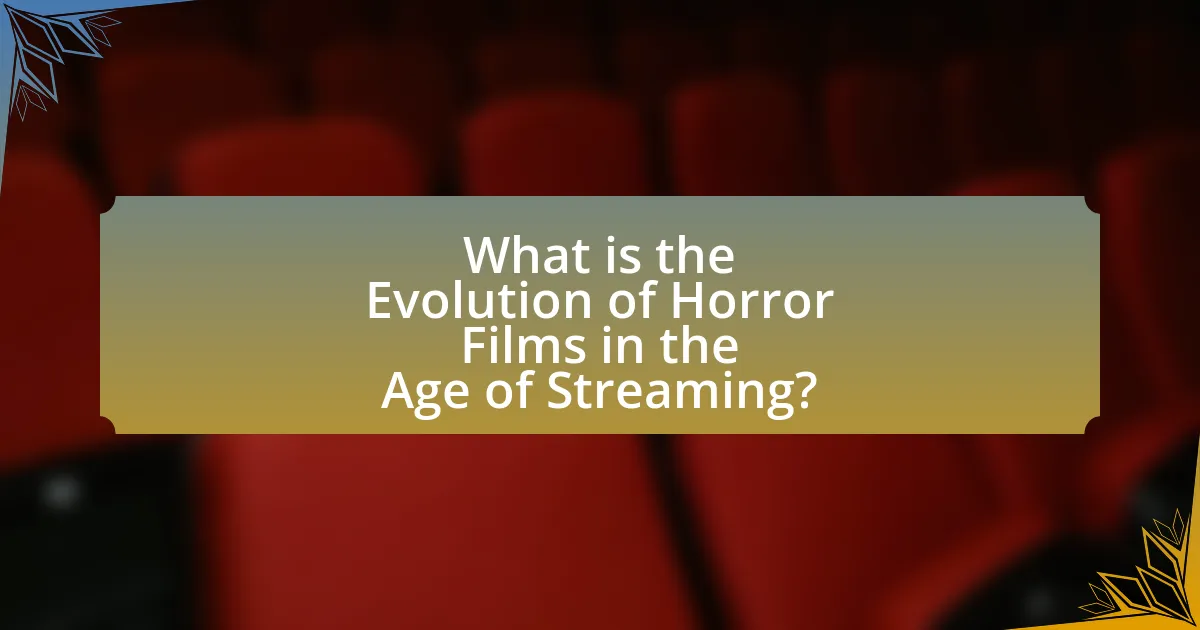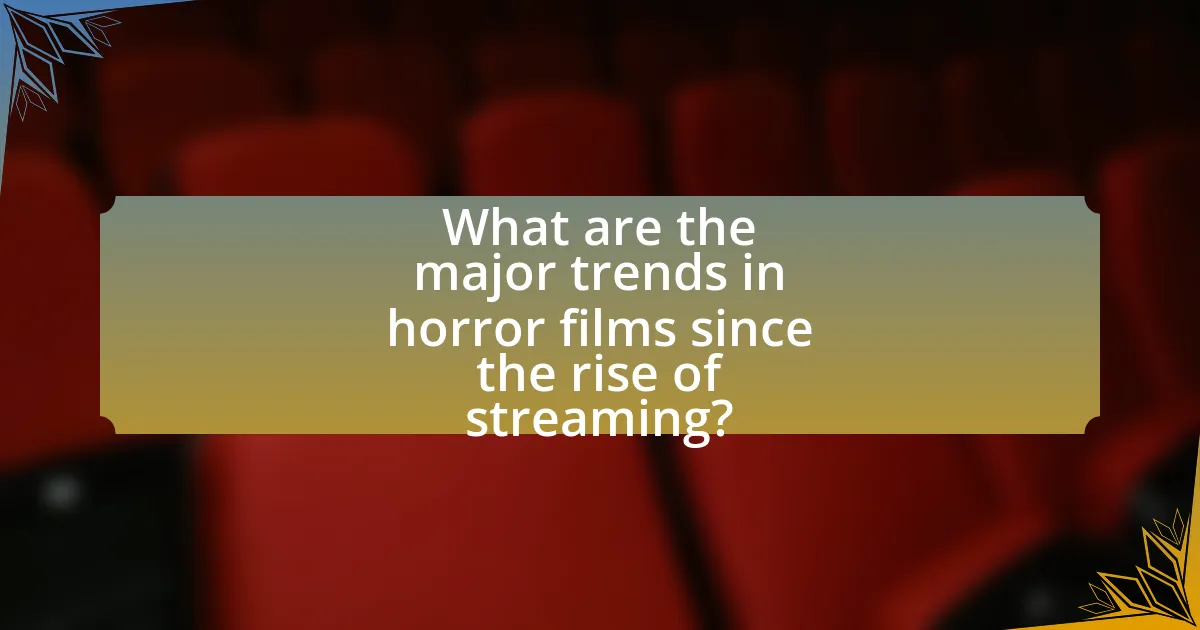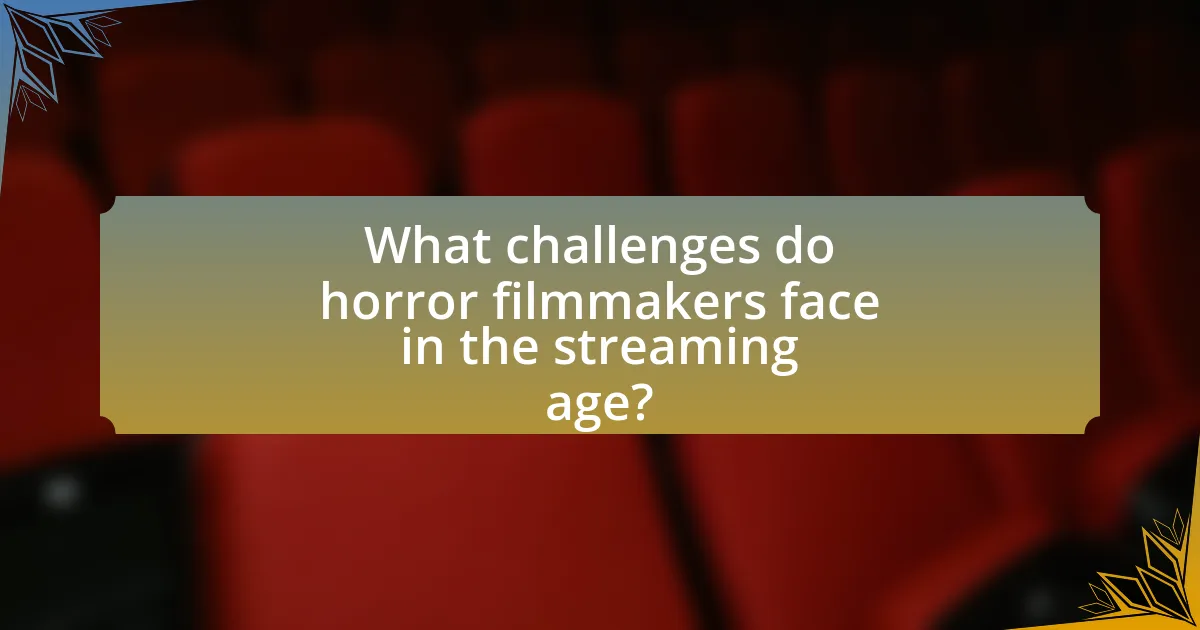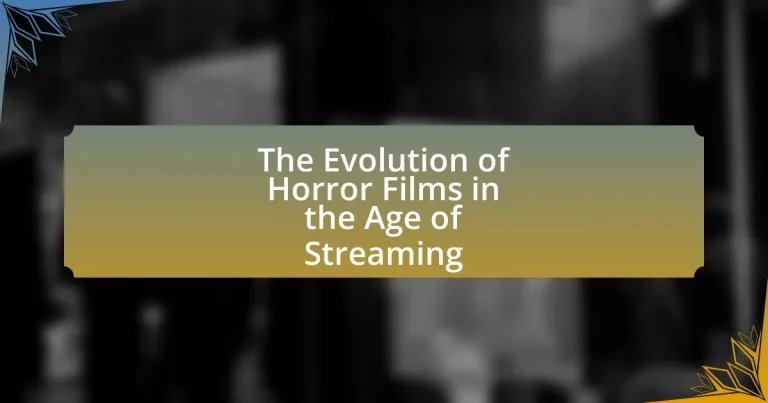The article examines the evolution of horror films in the age of streaming, highlighting how platforms like Netflix and Hulu have transformed the genre by increasing accessibility and diversifying storytelling. It discusses the impact of streaming on horror film production and distribution, emphasizing the rise of independent filmmakers and innovative narratives that reflect contemporary societal issues. Key characteristics of horror films in this era include the popularity of niche sub-genres, the influence of audience preferences on storytelling, and the challenges filmmakers face in a competitive streaming landscape. Additionally, the article explores the role of social media and viewer data in shaping horror film reception and marketing strategies, ultimately illustrating the significant cultural shifts that have influenced the horror genre in the streaming age.

What is the Evolution of Horror Films in the Age of Streaming?
The evolution of horror films in the age of streaming has transformed the genre by increasing accessibility, diversifying storytelling, and fostering innovative production techniques. Streaming platforms like Netflix, Hulu, and Amazon Prime have enabled a wider range of horror narratives, allowing independent filmmakers to reach global audiences without traditional distribution barriers. For instance, films such as “The Haunting of Hill House” and “Bird Box” have gained significant viewership and critical acclaim, showcasing how streaming services can elevate horror storytelling. Additionally, data from a 2021 report by the Motion Picture Association indicates that streaming services accounted for over 80% of the growth in the home entertainment market, highlighting the pivotal role of streaming in shaping contemporary horror cinema.
How has streaming changed the landscape of horror films?
Streaming has significantly transformed the landscape of horror films by increasing accessibility and diversifying content. Platforms like Netflix and Hulu have enabled a wider range of horror narratives, allowing independent filmmakers to reach global audiences without traditional distribution barriers. For instance, films such as “The Babadook” and “Cam” gained popularity through streaming services, showcasing unique storytelling that may not have thrived in theaters. Additionally, streaming has facilitated the rise of horror series, exemplified by shows like “The Haunting of Hill House,” which blend cinematic quality with episodic storytelling, further engaging viewers. This shift has led to a more varied and inclusive horror genre, reflecting diverse cultural perspectives and innovative concepts.
What are the key characteristics of horror films in the streaming era?
Key characteristics of horror films in the streaming era include increased accessibility, diverse storytelling, and innovative production techniques. Streaming platforms allow for a wider range of horror narratives, catering to niche audiences and global perspectives, as evidenced by the success of films like “His House” and “The Platform,” which explore unique cultural themes. Additionally, the lower barriers to entry for filmmakers have led to a surge in independent horror productions, resulting in a variety of styles and formats, such as found footage and anthology series. The data from the streaming industry indicates that horror consistently ranks among the most-watched genres, highlighting its popularity and the effectiveness of binge-watching formats in enhancing viewer engagement with suspenseful content.
How do streaming platforms influence horror film production and distribution?
Streaming platforms significantly influence horror film production and distribution by providing filmmakers with greater creative freedom and direct access to global audiences. These platforms, such as Netflix and Hulu, often prioritize original content, allowing horror filmmakers to experiment with unconventional narratives and styles that may not succeed in traditional theatrical releases. For instance, Netflix’s investment in horror has led to successful films like “Bird Box,” which garnered over 45 million views in its first week, demonstrating the platform’s ability to reach vast audiences quickly. Additionally, streaming services facilitate the distribution of niche horror films that might struggle to find a place in cinemas, thus broadening the genre’s reach and diversity. This shift has resulted in a more varied landscape for horror films, where both mainstream and independent creators can thrive.
Why is the evolution of horror films significant in today’s entertainment industry?
The evolution of horror films is significant in today’s entertainment industry because it reflects changing societal fears and technological advancements that shape audience engagement. As horror films have transitioned from traditional cinema to streaming platforms, they have adapted to new storytelling techniques and audience preferences, leading to innovative narratives and diverse representation. For instance, the rise of psychological horror and social commentary in films like “Get Out” has resonated with contemporary issues, enhancing viewer connection and relevance. Additionally, the accessibility of horror content on streaming services has increased its popularity, with platforms like Netflix reporting that horror is one of the most-watched genres, indicating a strong demand and cultural impact.
What cultural shifts have influenced horror films in the streaming age?
Cultural shifts such as the rise of social media, increased accessibility to diverse narratives, and changing audience expectations have significantly influenced horror films in the streaming age. The proliferation of social media platforms has allowed for real-time audience engagement and feedback, shaping the themes and marketing strategies of horror films. Additionally, streaming services have democratized content creation, enabling filmmakers from various backgrounds to share unique stories that reflect contemporary societal fears and anxieties. This shift has led to a broader representation of horror subgenres, including psychological horror and social commentary, which resonate with modern audiences. For instance, films like “Get Out” and “The Babadook” have successfully integrated social issues into their narratives, reflecting cultural conversations around race and mental health, respectively.
How do audience preferences shape horror film narratives and styles?
Audience preferences significantly shape horror film narratives and styles by influencing the themes, character development, and visual aesthetics that filmmakers prioritize. For instance, the rise of streaming platforms has led to an increased demand for diverse storytelling, prompting creators to explore unconventional narratives that resonate with varied audience demographics. This shift is evidenced by the success of films like “Get Out,” which combines social commentary with horror, appealing to audiences seeking deeper meaning alongside traditional scares. Additionally, audience engagement metrics on streaming services inform filmmakers about popular tropes and styles, leading to the incorporation of elements such as psychological horror and found footage techniques, which have gained traction due to viewer preferences for immersive and relatable experiences.

What are the major trends in horror films since the rise of streaming?
The major trends in horror films since the rise of streaming include an increase in diverse storytelling, the popularity of anthology formats, and the blending of genres. Streaming platforms have enabled filmmakers to explore unconventional narratives, such as those featuring marginalized voices, which has led to a broader representation in horror. For instance, films like “Get Out” and “His House” have gained critical acclaim for their unique perspectives. Additionally, anthology series like “The Haunting of Hill House” and “Into the Dark” have become popular, allowing for varied storytelling within a single series. The blending of genres, such as horror-comedy seen in “The Babysitter” and “What We Do in the Shadows,” has also gained traction, appealing to a wider audience. These trends reflect the evolving landscape of horror in the streaming era, driven by audience demand for innovation and inclusivity.
How have horror sub-genres evolved with streaming services?
Horror sub-genres have evolved significantly with the rise of streaming services, leading to increased diversity and accessibility. Streaming platforms like Netflix, Hulu, and Amazon Prime have enabled niche horror sub-genres, such as psychological horror, folk horror, and elevated horror, to gain visibility and attract dedicated audiences. For instance, the success of films like “The Babadook” and “Hereditary” demonstrates how streaming services have facilitated the emergence of more complex narratives that challenge traditional horror tropes. Additionally, the data from a 2021 report by the Motion Picture Association indicates that horror films accounted for 16% of all films released on streaming platforms, highlighting their growing prominence. This shift has allowed for innovative storytelling and a broader range of voices in horror, reflecting cultural changes and audience preferences.
What are the most popular horror sub-genres on streaming platforms?
The most popular horror sub-genres on streaming platforms include psychological horror, supernatural horror, slasher films, and found footage. Psychological horror focuses on the mental and emotional states of characters, often creating tension through suspense and fear of the unknown. Supernatural horror involves elements like ghosts, demons, and otherworldly beings, appealing to audiences’ fascination with the unexplained. Slasher films, characterized by a killer stalking and murdering a group of people, have maintained popularity due to their thrilling and often gory content. Found footage, which presents the story through supposedly discovered video recordings, has gained traction for its immersive and realistic approach. These sub-genres reflect viewer preferences and trends, as evidenced by streaming platform analytics showing high engagement rates for these categories.
How do streaming services promote niche horror films?
Streaming services promote niche horror films through targeted marketing strategies, algorithm-driven recommendations, and curated content collections. These platforms utilize data analytics to identify viewer preferences, allowing them to suggest niche horror titles to specific audience segments. For instance, Netflix employs algorithms that analyze user behavior, leading to personalized recommendations that highlight lesser-known horror films based on viewing history. Additionally, streaming services often create themed collections or playlists, such as “Cult Classics” or “International Horror,” which showcase niche films and make them more accessible to viewers. This approach not only increases visibility for these films but also fosters a community of genre enthusiasts, as evidenced by the growing popularity of niche horror films on platforms like Shudder, which specializes in horror content.
What role do original content and exclusives play in horror film evolution?
Original content and exclusives are pivotal in the evolution of horror films, as they drive innovation and audience engagement. Streaming platforms like Netflix and Hulu have invested heavily in original horror films, allowing for diverse storytelling that often deviates from traditional horror tropes. For instance, films such as “The Haunting of Hill House” and “Bird Box” have not only garnered critical acclaim but also attracted large viewership, demonstrating the demand for unique narratives. This shift towards original content has led to a broader exploration of themes, styles, and cultural perspectives within the horror genre, ultimately reshaping audience expectations and industry standards.
How do original horror films on streaming platforms compare to traditional releases?
Original horror films on streaming platforms often prioritize innovative storytelling and diverse representation compared to traditional releases. Streaming platforms like Netflix and Hulu have the flexibility to explore unconventional narratives and niche themes, which can lead to unique horror experiences that may not fit the mainstream mold. For instance, films such as “The Platform” and “His House” have gained critical acclaim for their fresh perspectives and social commentary, showcasing how streaming services can push creative boundaries. Additionally, the accessibility of these films allows for a broader audience reach, as viewers can easily discover and engage with content that may not have received theatrical distribution. This shift reflects a significant evolution in the horror genre, emphasizing originality and inclusivity in storytelling.
What impact do exclusive horror series have on viewer engagement?
Exclusive horror series significantly enhance viewer engagement by creating a dedicated fanbase and fostering community discussions. The unique storytelling and immersive experiences offered by these series often lead to higher viewer retention rates, as evidenced by platforms like Netflix, which reported that horror series such as “The Haunting of Hill House” attracted millions of viewers and generated extensive online discourse. This engagement is further amplified by social media interactions, where fans share theories and reactions, thus increasing the series’ visibility and appeal.

What challenges do horror filmmakers face in the streaming age?
Horror filmmakers face significant challenges in the streaming age, primarily due to increased competition and the need for differentiation. The proliferation of streaming platforms has led to an oversaturation of content, making it difficult for horror films to stand out. According to a report by PwC, the global streaming market is expected to reach $100 billion by 2025, intensifying the competition among filmmakers. Additionally, horror filmmakers must navigate the complexities of audience preferences, as streaming algorithms often prioritize mainstream genres over niche categories like horror. This can result in reduced visibility for innovative horror projects, limiting their potential audience reach. Furthermore, the shift to streaming has altered traditional revenue models, making it challenging for filmmakers to secure funding and distribution deals that were once more accessible in theatrical releases.
How do budget constraints affect horror film production?
Budget constraints significantly limit the resources available for horror film production, impacting aspects such as special effects, location choices, and talent acquisition. Lower budgets often lead filmmakers to prioritize innovative storytelling and practical effects over expensive CGI, as seen in successful low-budget horror films like “The Blair Witch Project,” which was produced for approximately $60,000 and grossed nearly $250 million worldwide. Additionally, budget limitations can necessitate shooting in fewer locations and using smaller casts, which can enhance the film’s intimacy and focus on character development, ultimately influencing the narrative style and audience engagement.
What strategies do filmmakers use to create effective horror on a budget?
Filmmakers create effective horror on a budget by utilizing strategies such as focusing on psychological tension, leveraging sound design, and employing minimalistic settings. Psychological tension engages audiences through fear of the unknown, which can be achieved without expensive special effects. For instance, films like “Paranormal Activity” relied heavily on suspense and atmosphere rather than costly visuals, demonstrating that a compelling narrative can drive horror effectively. Additionally, sound design plays a crucial role; filmmakers often use unsettling audio cues to evoke fear, as seen in “A Quiet Place,” where silence amplifies tension. Lastly, minimalistic settings reduce production costs while enhancing the claustrophobic feel essential to horror, as exemplified by “The Blair Witch Project,” which effectively used its limited environment to create a sense of dread. These strategies collectively prove that budget constraints do not hinder the creation of impactful horror films.
How does competition among streaming platforms impact horror film visibility?
Competition among streaming platforms significantly enhances horror film visibility. As platforms vie for subscriber attention, they prioritize diverse content, including horror films, to attract and retain viewers. This competition leads to increased marketing efforts, such as targeted promotions and curated lists, which elevate the profile of horror films. For instance, platforms like Netflix and Hulu have invested heavily in original horror content, resulting in a 30% increase in horror film viewership over the past five years, according to a 2022 report by the Motion Picture Association. Consequently, the competitive landscape not only broadens the audience reach for horror films but also encourages innovation in storytelling and production quality within the genre.
What are the implications of audience feedback on horror films in streaming?
Audience feedback significantly influences the production and marketing of horror films in streaming. Streaming platforms utilize viewer ratings, reviews, and social media interactions to gauge audience preferences, which directly impacts decisions on content acquisition, development, and promotional strategies. For instance, data from platforms like Netflix shows that user engagement metrics, such as completion rates and viewer ratings, inform the types of horror films that are greenlit or promoted, leading to a more tailored viewing experience. This responsiveness to audience feedback can enhance viewer satisfaction and retention, as evidenced by the success of films that align closely with audience expectations and preferences.
How do streaming platforms utilize viewer data to influence horror film development?
Streaming platforms utilize viewer data to influence horror film development by analyzing viewing habits, preferences, and engagement metrics to tailor content that resonates with audiences. For instance, platforms like Netflix and Amazon Prime Video track which horror films are most watched, the demographics of viewers, and the specific elements that keep audiences engaged, such as jump scares or psychological themes. This data-driven approach allows these platforms to identify trends and gaps in the market, leading to the production of horror films that align with viewer interests. A report by Deloitte in 2021 indicated that 80% of streaming services use viewer data to inform their content strategy, demonstrating the significant impact of data analytics on film development decisions.
What role does social media play in shaping horror film reception?
Social media significantly influences the reception of horror films by facilitating immediate audience engagement and feedback. Platforms like Twitter, Instagram, and TikTok allow viewers to share their reactions, create viral trends, and generate buzz around new releases, which can enhance visibility and interest. For instance, the success of films like “A Quiet Place” and “Hereditary” can be attributed to social media campaigns that encouraged user-generated content, leading to increased box office performance. Additionally, studies show that films with strong social media presence often receive higher ratings on platforms like Rotten Tomatoes, indicating a correlation between online engagement and critical reception.
What are some best practices for creating successful horror films in the streaming era?
To create successful horror films in the streaming era, filmmakers should focus on strong storytelling, innovative concepts, and effective marketing strategies. Strong storytelling engages viewers emotionally, making them more invested in the characters and plot. Innovative concepts, such as unique twists on traditional horror tropes, can capture audience interest and differentiate a film in a crowded market. Effective marketing strategies, including targeted social media campaigns and collaborations with influencers, can enhance visibility and attract a larger audience. According to a 2021 report by Statista, streaming services accounted for over 80% of video-on-demand revenue, highlighting the importance of adapting to this distribution model for success.
How can filmmakers effectively market their horror films on streaming platforms?
Filmmakers can effectively market their horror films on streaming platforms by utilizing targeted social media campaigns and engaging with niche communities. Social media platforms like Instagram and TikTok allow filmmakers to create visually compelling content that resonates with horror fans, such as behind-the-scenes footage, teaser trailers, and interactive polls. Engaging with niche communities on platforms like Reddit or horror-specific forums can also generate buzz and foster a dedicated audience. According to a 2021 study by the Pew Research Center, 69% of adults in the U.S. use social media, making it a vital tool for reaching potential viewers. Additionally, leveraging user-generated content and influencer partnerships can amplify reach and credibility, as horror fans often trust recommendations from peers and influencers within the genre.
What elements contribute to a horror film’s success in the age of streaming?
Horror films succeed in the age of streaming due to a combination of engaging storytelling, innovative marketing strategies, and audience accessibility. Engaging storytelling captivates viewers, as evidenced by films like “The Haunting of Hill House,” which received critical acclaim for its character development and emotional depth. Innovative marketing strategies, such as viral social media campaigns, enhance visibility and attract audiences; for instance, “Bird Box” gained massive attention through its unique promotional tactics. Additionally, audience accessibility through streaming platforms allows for a broader reach, with Netflix reporting that “Bird Box” was viewed by over 45 million accounts in its first week, demonstrating the impact of easy access on viewership.


